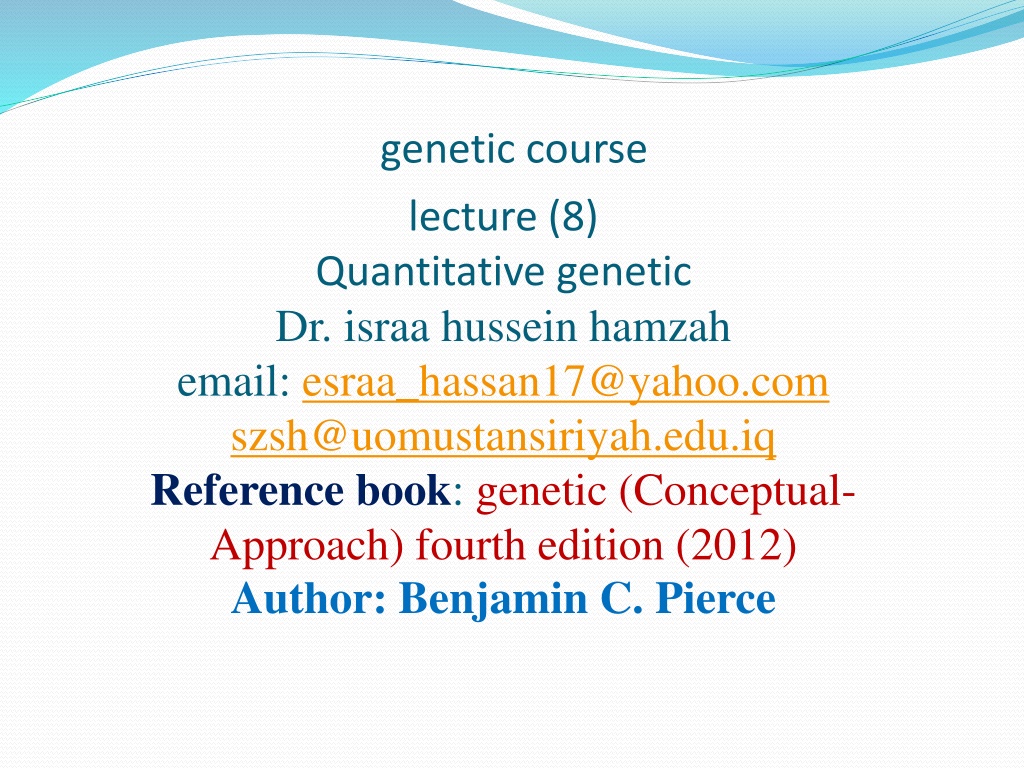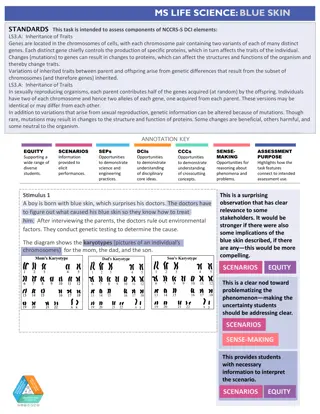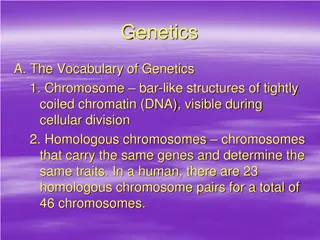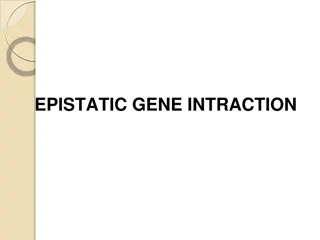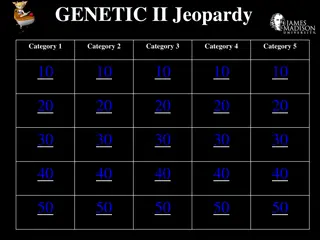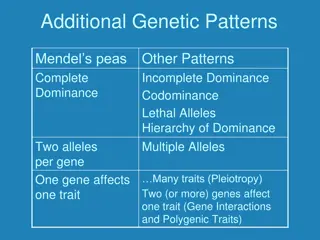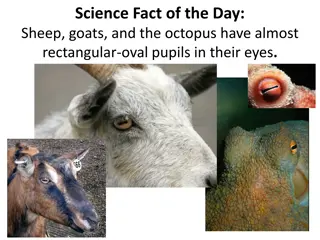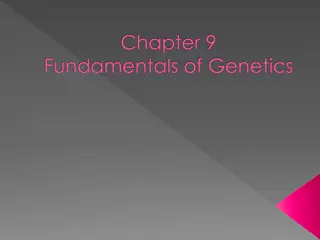Quantitative Genetic Traits and Inheritance
The phenotypic traits of organisms can be qualitative or quantitative. Qualitative traits show clear differences, while quantitative traits form a spectrum of blended phenotypes. Quantitative traits, such as height, weight, and behavior, are economically significant and influenced by multiple genes and environmental factors. Understanding qualitative and quantitative genetics helps differentiate between discrete and continuous variations in inheritance patterns.
Download Presentation

Please find below an Image/Link to download the presentation.
The content on the website is provided AS IS for your information and personal use only. It may not be sold, licensed, or shared on other websites without obtaining consent from the author.If you encounter any issues during the download, it is possible that the publisher has removed the file from their server.
You are allowed to download the files provided on this website for personal or commercial use, subject to the condition that they are used lawfully. All files are the property of their respective owners.
The content on the website is provided AS IS for your information and personal use only. It may not be sold, licensed, or shared on other websites without obtaining consent from the author.
E N D
Presentation Transcript
genetic course lecture (8) Quantitative genetic Dr. israa hussein hamzah email: esraa_hassan17@yahoo.com szsh@uomustansiriyah.edu.iq Reference book: genetic (Conceptual- Approach) fourth edition (2012) Author: Benjamin C. Pierce
Quantitative genetics The phenotypic traits of the different organisms may be of two kinds, viz., qualitative and quantitative. The quali tative traits are the classical Mendelian traits of kinds such as form (e.g., round or wrinkled seeds of pea); structure e.g., horned or hornless condition in cattles) ; pigments (e.g.,black or white coat of guinea pigs); and antigens and antibodies (e.g blood group types of man) and so on. qualitative trait may be under genetic control of two or many alleles of a single gene with little or no environmental modifications to obscure the gene effects. The organisms possessing qualitative traits have distinct (separate) phenotypic classes and are said to exhibit discontinuous variations.
The quantitative traits, however, are economically important measurable phenotypic traits of degree such as height, weight, shape, skin pigmentation, metabolic activity, reproductive rate, behaviour, eye-facet or bristle number in Drosophila, susceptibility to pathological diseases or intelligence in man; amount of flowers, fruits, seeds, milk, meat or egg produced by plants or animals, etc. Economically important traits such as body weight gains, mature plant heights, egg or milk production records
The quantitative traits are also called metric traits. They do not show clear cut differences between individuals and forms a spectrum of phenotypes which blend imperceptively from one type to another to cause continuous variations In contrast to qualitative traits, the quantitative traits may be modified variously by the environmental conditions and are usually governed by many factors or genes (perhaps 10 or 100 or more), each contributing such a small amount of phenotype that their individual effects cannot be detected by Mendelian methods but by only statistical methods. Such genes which are nonallelic and affect the phenotype of a single quantitative trait, are called polygenes or cumulative genes. The inheritance of polygenes or quantitative traits is called quantitative. inheritance,
The genetical studies of qualitative and quantitative traits are called qualitative genetics and quantitative genetics, respectively. The major differences between the two are following Qualitative genetics Quantitative genetics 1-. Characters of kind. 1. Characters of degree 2-Discontinuous phenotypic class. variation; distinct 2. Continuous phenotypic form a spectrum. variations; 3. Single gene effects. 3. Polygenic control; effects of single genes too slight to be detected 4. Concerned with population of organisms consisting of all possible kinds of matings. 4-Concerned with individual matings and their progeny. 5. Statistical analyses give estimates of population parameters such as the mean and standard deviation. 5. Analyzed by making counts and ratios
CHARACTERISTICS OF MULTIPLE GENES Multiple genes for quantitative traits have following characteristics:- 1- Each contributing allele in the series of multiple genes produces an equal effect 2- Effects of each contributing allele are cumulative or additive 3- There is no dominance 4-There is no epistasis (masking of the phenotypes(among genes at different loci. 5- There is no linkage involved. 6-The environmental conditions have considerable effect on the phenotypic expression of polygenes for the quantitative traits.
EXAMPLES OF QUANTITATIVE INHERITANCE 1. Kernel Colour in Wheat A whole grain or seed of a cereal plant such as corn, wheat, barley, etc., is called kernel. Kernel colour in wheat is a quantitative trait and its inheritance was studied by Swedish geneticist When he crossed a certain red strain to a white strain, he observed that the F1 was all light red and that approximately 1/16 of the F2 was as extreme as the parents, i.e., 1/16 was white and 1/16 was red. He interpreted these results in terms of two genes, each with a pair of alleles exhibiting cumulative effect P : Red kernel White kernel R1R1R2R2 r1 r1 r2 r2 F1 : Light red R1 r1 R2 r2
Each of the contributing alleles R1 or R2 adds some red to the phenotype of kernel colour, so that the genotypes of whites contain neither of these alleles and a red genotype contains only R1 and R2 alleles. histograms in Here five phenotypic classes are obtained in F2; each dose of a contributing allele for pigment production increases depth of colour.
F2 : Summary of checker board derived results, i.e., F2 genotypic and phenotypic ratios Phenotype Genotype Genotypic Number of contributing alleles 4 Phenotype ratio ratio R1 R1 R2 R2 1 red 1 R1 R1 R2 r2 2 Medium red 4 R1 r1 R2 R2 2 3 4 Light red 6 15\16 R1 r1 R2 r2 Color red 1 2 R1 R1 r2 r2 1 2 r1 r1 R2 R2 R1 r1 r2 r2 Very light red 4 r1 r1 R2 r2 2 1 r1 r1 r2 r2 1 0 White 1 { 1\16} colorless
2- Skin Colour in Man Another classical example of polygenic inheritance was given by Davenport (1913) in Jamaica. He found that two pairs of genes, A-a and B-b cause the difference in skin pigmentation between negro and caucasian people. These genes were found to affect the character in additive fashion. Thus, a true negro has four d o m i n a n t genes, AABB and a white has four recessive genes aabb. The F1 offspring of mating of aabb with AABB, are all AaBb and have an intermediate skin colour termed mulatto.
Negro White P1 : AABB aabb gametes : AB ab F1 : AaBb Mulattoes Intermediate skin colour Mulattoes Mulattoes Intercross : Aa Bb AaBb mating of two such mulattoes produces a wide variety of skin colour in the offspring, ranging from skins as dark as the original negro parent to as white as the original white parent.
Male AB Ab aB ab Female AB AABB AABb AaBB AaBb Like negro Darker than mulattoes Darker than mulattoes like mulattoes Ab AABb AAbb AaBb Aabb Darker than mulattoes AaBB Like mulattoes AaBb Like mulattoes aaBB Lighter than mulattoes aaBb aB Darker than mulattoes Like mulattoes Like mulattoes Like mulattoes ab AaBb Aabb aaBb aabb Like mulattoes Lighter than mulattoes Lighter than mulattoes white
F2=negro color (1\16) , Colour between mulattoes and negro(4\16) ,color of mulattoes (6\16) , Colour between mulattoes and white (4\16), white skin color(1\16). SIGNIFICANCE OF QUANTITATIVE GENETICS Quantitative genetics has great agricultural importance and has helped in the increase of yield of various economically important crops. Q\ Which of the following human phenotypes would appear to be based on polygene inheritance : intelligence, absence of incisors, height, phenylketonuria, ability to taste phenylthiocarbamide, skin colour, eye colour ? Answer/ All traits showing practically continuous variation are likely to be due to polygenes. Here, the traits of intelligence, height, skin colour, and eye colour probably involve polygenes.
